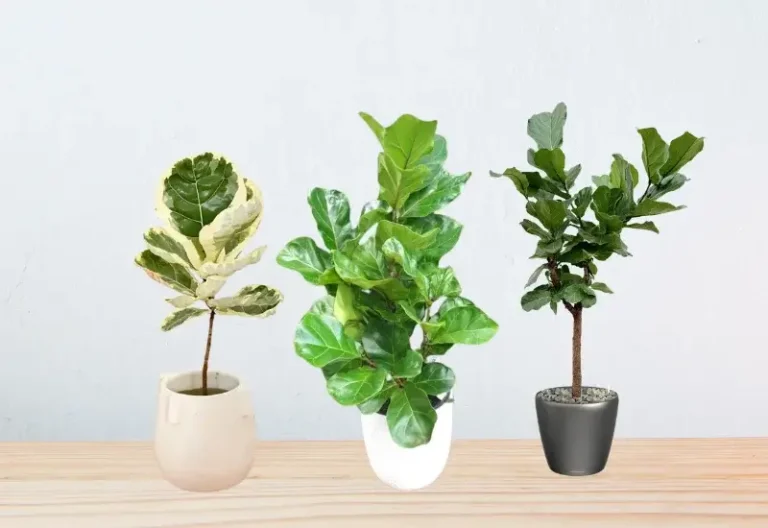The Ultimate Guide Ficus Lyrata or Fiddle Leaf Fig Care
Ficus Lyrata, more commonly known as the Fiddle Leaf Fig, is a delightful houseplant that has captured the hearts of plant enthusiasts with its large, violin-shaped leaves.
| Basic Information for Ficus Lyrata | |
| Common Name | Ficus Lyrata |
| Botanical Name | Ficus lyrata |
| Family | Allow the top inch of soil to dry |
| Native To | West Africa |
| Type | Evergreen, indoor houseplant |
| Mature Height | Up to 6-10 feet (1.8-3 meters) |
| Leaves | Large, violin-shaped, glossy |
| Light | Bright, indirect light |
| Temperature | 65-75°F (18-24°C) |
| Humidity | Moderate |
| Watering | Allow top inch of soil to dry |
| Soil | Well-draining potting mix |
| Fertilizing | Balanced, water-soluble fertilizer with 3:1:2 or 3:2:1 N-P-K ratio during growing season |
| Common Issues | Overwatering, underwatering, root rot, leaf drop |
| Toxicity | Toxic to pets if ingested |
The Ficus Lyrata, or Fiddle Leaf Fig, hails from the tropical rainforests of West Africa. In its natural habitat, this plant can reach towering heights of up to 50 feet. Its striking appearance is characterized by its enormous, glossy, and violin-shaped leaves that can grow up to 18 inches long. This lush, green beauty has found a special place in homes worldwide, and with the right care, it can become a magnificent addition to your indoor garden.
Ficus Lyrata Indoor
The Ficus Lyrata is exceptionally suited for indoor living. Its adaptability to indoor conditions makes it a popular choice for homes and offices.
Here are some tips for creating the perfect indoor environment for your Fiddle Leaf Fig:
Selecting the Right Spot: Choose a location with bright, indirect light. Ficus Lyrata thrives near a window with filtered sunlight. Avoid placing it in direct sun, which can scorch its delicate leaves.
Room Temperature: Ficus Lyrata prefers a consistent room temperature between 65-75°F (18-24°C). Avoid exposing it to drafts or sudden temperature fluctuations.
Ficus Lyrata Care
Ficus Lyrata, commonly known as the Fiddle Leaf Fig, is a visually striking and popular houseplant, known for its large, violin-shaped leaves.
Light Requirements
Bright, Indirect Light: Ficus Lyrata flourishes in bright, indirect sunlight. Place it near a window with filtered light, but avoid direct sun exposure, which can lead to leaf burn. If you don’t have access to bright natural light, consider using artificial grow lights to provide the necessary light levels.
Rotate Your Plant: To ensure even growth and prevent your Fiddle Leaf Fig from leaning towards the light source, rotate it every few weeks.
Watch for Warning Signs: Pay attention to your plant’s behavior. If it starts dropping leaves or develops leggy growth, it may be receiving too little or too much light. Adjust its placement accordingly.
Temperature and Humidity
Consistent Room Temperature: Ficus Lyrata prefers a stable indoor temperature between 65-75°F (18-24°C). Avoid exposing it to drafts or sudden temperature changes, such as cold air from air conditioning or heating vents.
Humidity: While not overly demanding, Ficus Lyrata benefits from moderate humidity levels. If your indoor air is dry, consider increasing humidity around the plant. You can do this by using a humidity tray, misting the leaves occasionally, or using a room humidifier.
Watering
Allow Soil to Dry: Water your Fiddle Leaf Fig when the top inch of the soil feels dry to the touch. Stick your finger into the soil to gauge its moisture level. Ensure that the pot has proper drainage to prevent water from pooling at the bottom.
Use Room-Temperature Water: Use room-temperature water for watering your plant. Cold water can shock the roots.
Watering Frequency: The frequency of watering will depend on factors like your indoor humidity, temperature, and the size of the pot. In general, water your Ficus Lyrata every 1-2 weeks, but adjust based on the specific conditions of your home.
Avoid Overwatering: Overwatering is a common issue with Fiddle Leaf Figs. Excess moisture can lead to root rot. If in doubt, it’s safer to underwater slightly than to overwater.
Soil
Well-Draining Soil: Ficus Lyrata thrives in a well-draining potting mix. This prevents water from collecting around the roots, reducing the risk of root rot. Consider using a high-quality potting mix designed for indoor plants or create your own blend of potting soil, perlite, and orchid bark.
Repotting: As your Ficus Lyrata grows, it may outgrow its pot. Repot in the spring if you notice it becoming root-bound. Select a slightly larger pot with good drainage to accommodate its growing roots.
Fertilizing
Balanced Fertilizer: Use a balanced, water-soluble fertilizer with an N-P-K ratio of 3:1:2 or 3:2:1. Fertilize during the growing season, which typically falls in the spring and summer months. Fertilize about once a month during this period.
Dilution Matters: Always follow the recommended dosage on the fertilizer label. Over-fertilizing can harm your plant, so it’s best to err on the side of caution.
Reduce in Winter: During the dormant season, in fall and winter, reduce or halt fertilization since the plant’s growth naturally slows down during this time.
By following these care guidelines, you can enjoy a thriving and healthy Ficus Lyrata, adding a touch of lush greenery to your indoor space. Remember that plants, like pets, thrive with consistent care and attention, so monitor your Fiddle Leaf Fig regularly and adjust its care as needed.
Conclusion
Ficus Lyrata, the Fiddle Leaf Fig, is a magnificent houseplant that can flourish in your indoor space with the right care. Providing suitable light, well-draining soil, and balanced fertilization ensures your Fiddle Leaf Fig will continue to grace your home with its stunning foliage. With a little attention and a touch of green-thumb magic, your Ficus Lyrata will thrive and brighten up your living space.





